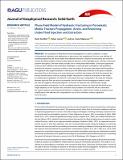Phase Field Model of Hydraulic Fracturing in Poroelastic Media: Fracture Propagation, Arrest, and Branching Under Fluid Injection and Extraction
Author(s)
Santillán, David; Juanes, Ruben; Cueto-Felgueroso Landeira, Luis
Downloadsantillan_juanes_cueto_jgr_2018.pdf (3.822Mb)
PUBLISHER_POLICY
Publisher Policy
Article is made available in accordance with the publisher's policy and may be subject to US copyright law. Please refer to the publisher's site for terms of use.
Terms of use
Metadata
Show full item recordAbstract
The simulation of fluid-driven fracture propagation in a porous medium is a major computational challenge, with applications in geosciences and engineering. The two main families of modeling approaches are those models that represent fractures as explicit discontinuities and solve the moving boundary problem and those that represent fractures as thin damaged zones, solving a continuum problem throughout. The latter family includes the so-called phase field models. Continuum approaches to fracture face validation and verification challenges, in particular grid convergence, well posedness, and physical relevance in practical scenarios. Here we propose a new quasi-static phase field formulation. The approach fully couples fluid flow in the fracture with deformation and flow in the porous medium, discretizes flow in the fracture on a lower-dimension manifold, and employs the fluid flux between the fracture and the porous solid as coupling variable. We present a numerical assessment of the model by studying the propagation of a fracture in the quarter five-spot configuration. We study the interplay between injection flow rate and rock properties and elucidate fracture propagation patterns under the leak-off toughness dominated regime as a function of injection rate, initial fracture length, and poromechanical properties. For the considered injection scenario, we show that the final fracture length depends on the injection rate, and three distinct patterns are observed. We also rationalize the system response using dimensional analysis to collapse the model results. Finally, we propose some simplifications that alleviate the computational cost of the simulations without significant loss of accuracy. Keywords: phase field model; hydraulic fracturing; poroelasticity fracture; coupled problems
Date issued
2018-02Department
Massachusetts Institute of Technology. Department of Civil and Environmental Engineering; Massachusetts Institute of Technology. Department of Earth, Atmospheric, and Planetary SciencesJournal
Journal of Geophysical Research: Solid Earth
Publisher
American Geophysical Union (AGU)
Citation
Santillán, David et al. “Phase Field Model of Hydraulic Fracturing in Poroelastic Media: Fracture Propagation, Arrest, and Branching Under Fluid Injection and Extraction.” Journal of Geophysical Research: Solid Earth 123, 3 (March 2018): 2127–2155 © 2018 American Geophysical Union
Version: Final published version
ISSN
2169-9356
2169-9313